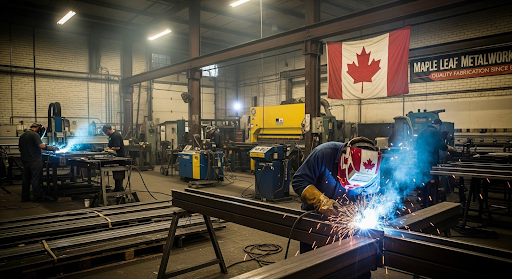Metal fabrication is what keeps Canadian industry on its feet, supporting construction, auto and aerospace, and everything in between. Ten years ago, technology changed the way metal fabrication shops operate, moving them towards higher accuracy, pace, and efficiency. From computer-aided design programs to robotics, advanced technology not only increases production—new equipment is redefining the definition of quality and consistency. Canadian metal fabrication shops using these technologies are positioning themselves for competitive success in an ever-evolving marketplace.
Why Technology Is Necessary in Metal Fabrication
Metal fabrication in the past depended significantly on human ability, time, and labor. Although craftsmanship cannot be avoided, applying technology enables shops to:
- Minimize waste and errors
- Boost production rate
- Process intricate designs easily
- Enhance workers’ safety and minimize physical strain
With technology, Canadian fabrication plants can manufacture high-quality goods and compete effectively and affordably.
Computer-Aided Design (CAD) and CAM Systems
One of the most revolutionary metal working tools is CAD (Computer-Aided Design) technology. CAD enables designers and engineers to make precise electronic blueprints of parts prior to manufacture. With CAM (Computer-Aided Manufacturing) included, the designs are taken straight to the machines eliminating possible errors and streamlining processes.
Advantages of CAD/CAM integration are:
- More precise measurements with fewer errors
- Quicker iteration on the design
- Seamless communication between production and design workers
- Pre-cutting complex assemblies
CAD and CAM technology facilities achieve greater efficiency and cheaper errors for Canadian fabrication shops.
Automation and CNC Machines
Computer Numerical Control (CNC) machines revolutionized the domain of metal cutting, bending, and forming. CNC machines are computer-controlled to ensure accurate parts each time. Computer automation enables CNC systems to carry out long production sequences with minimal manual interference.
Key benefits are:
- Extremely high repeatability for high-volume runs
- Fewer manual labour and increased safety
- Greater ability to work with complex shapes
- Quicker to redeliver jobs
Automation may also enable stores to economically expand production, keeping up with the expanding demands of Canadian producers without sacrificing quality.
Robotics in Fabrication
Besides welding, assembly, and the transfer of material are being done by robotic arm. They can perform tasks endlessly at high precision levels, allowing workers to concentrate on more complex aspects of the process.
Advantages of robotics:
- Consistent quality of welding
- Lower worker fatigue
- Better workplace safety
- Increased output without losing accuracy
Robotic equipment is especially beneficial to high-volume fabrication shops requiring speed and dependability both.
Advanced Materials and Cutting Technology
New fabrication technology is not only equipment but also new materials and cutting methods. Laser cutting, plasma cutting, and waterjet machines allow shops to cut stainless steel, aluminum, and composites accurately.
Benefits are:
- Cleaner cuts with less scrap
- Capacity to cut intricate designs and shapes
- Shorter lead times
- Compatibility with small or large projects
These technologies enable Canadian shops to be flexible and accommodate the varied needs of clients in industries.
Digital Tracking and Workflow Management
Computerized tracking software and workflow management systems are currently a requirement for productivity. The systems enable shops to track all stages of production, inventory, and scheduling optimization.
Advantages of computerized tracking are:
- Enhanced uptime through planning
- Enhanced inventory management
- Real-time team and customer notifications
- Streamlined quality control and reporting
With digital shop management software, the shop enhances business efficiency with accountability unscathed.
Quick Comparison: Old versus New Technology-Driven Fabrication
| Aspect | Traditional Fabrication | Technology-Driven Fabrication |
| Accuracy | Dependent on manual skill | High, machine-controlled |
| Production Speed | Slower, labor-intensive | Faster, automated workflows |
| Material Waste | Higher | Reduced through precision |
| Complexity | Limited | Can handle intricate designs |
| Workforce Focus | Manual execution | Supervision, design, and quality control |
FAQs
1. Is technology replacing metal fabrication workers?
No. Technology enhances human effort with precision, safety, and productivity. Expert operators are still needed to program, monitor, and make tough decisions.
2. What are the key technologies for modern shops?
Some of the most important are CAD/CAM software, CNC machines, robots, laser/plasma cutters, and workflow management software.
3. Can these technologies be afforded by Canadian small shops?
Initial cost may be high, but eventual productivity gains, elimination of errors, and expandability usually outweigh expense.
4. How does technology enhance safety?
Technology removes repetitive operations, heavy lifting, and exposure to unsafe processes, reducing workplace injury.
Key Takeaway
Technology is revolutionizing Canadian metal fabrication so that shops can make higher precision, intricate, and improved-quality parts more productively and safely. From CAD/CAM and CNC machines to robotics and non-traditional cutting tools, new technologies enable fabrication teams to fulfill growing industrial demands without compromising quality.
Conclusion
A Canadian metal fabrication shop embracing modern technology is positioning itself for long-term success. By combining skilled workers with automation, advanced equipment, and information technology, Canadian manufacturers can produce complex metal products faster and with fewer errors. Technology also ensures safer working conditions and cleaner production, keeping the industry competitive. The future of Canadian manufacturing belongs to those who combine innovation with hands-on expertise, building a more productive and innovative sector.

